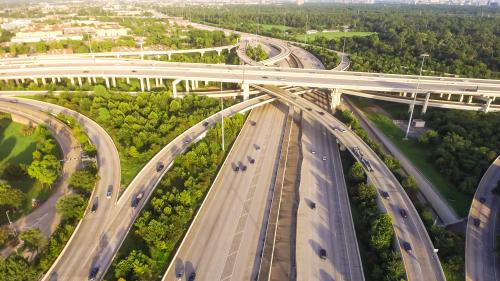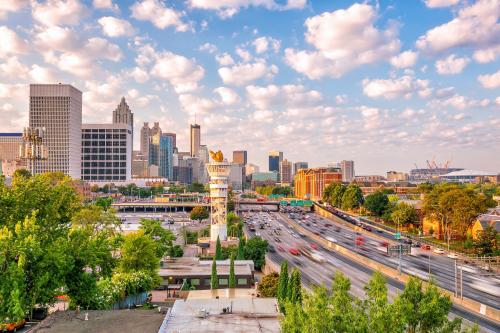Think about a day in the life of a typical office worker in the Washington, D.C. area. They take Metro to get to the office on time, order lunch to be delivered from the busy restaurant down the street, purchase tickets to a weekend matinee film, and call a Lyft home as hockey fans swarm the Metro. Finally, they end the night streaming a show on high-speed internet.
All of these activities, whether we realize it or not, take advantage of congestion pricing: paying a cost based on demand and the desire to avoid waiting. Riding the Metro at peak time, splurging on an additional fee to avoid the lunch line, receiving a discount for seeing a movie when few others choose to—we accept congestion pricing as a normal feature of everyday life.
So why, on our roads, is it considered taboo?
Congestion pricing on our nation’s roadways is forbidden in many cases, or rarely adjusted in others. We’re still stuck in traffic, with drivers wasting an average of 54 hours every year and costing the economy $166 billion.
What is so maddening is that we know how to fix the problem: Simply price use of the roads based on demand like any other good. There are multiple options for how to implement congestion pricing, some already demonstrated in cities across the world: adding new priced lanes (also known as managed lanes) to existing freeways; tolling non-carpool vehicles using high-occupancy vehicle lanes; or implementing a charge to enter congested central business districts (cordon pricing).
What is so maddening is that we know how to fix the problem: Simply price use of the roads based on demand like any other good. There are multiple options for how to implement congestion pricing, some already demonstrated in cities across the world.
Economists have long been advocating such proposals for efficiency, time savings, and the choice they provide users. And many states, including California, have moved forward with installing road pricing systems of their own on state freeways. However, the practice has been less prevalent in cities themselves, where traffic congestion is greatest in the urban core.
Fortunately, in the absence of state and federal action on the issue, a slew of forward-leaning cities are exploring ways to use congestion pricing to free up traffic and curb emissions.
Perhaps the nation’s biggest experiment in this arena is taking place in New York City. If all goes as planned come 2021, New York will be the first city in the United States to employ a cordon pricing system by charging drivers to access Manhattan south of 60th Street. One barrier to greenlighting such a plan were concerns about equity—that charging higher tolls would disproportionately hurt lower-income commuters, especially those from New York’s outer boroughs.
A closer look from an equity standpoint reveals that only 4% of outer-borough commuters drive into Manhattan for work, nearly all of whom are not poor. Furthermore, critics miss the fact that such pricing creates revenue to improve transportation options actually used by lower income workers. Indeed, New York’s cordon pricing is estimated to generate up to $1.1 billion a year for improving transit services.
Other cities are closely watching New York and examining congestion pricing within their own city limits:
- In Washington, D.C., commuters benefit from the extensive set of pricing systems in Virginia (and soon to be in Maryland), but not in the District itself. Washington has already implemented a demand-based pricing system for parking downtown, and the idea of expanding to the city’s roads has been mulled over in the city council. Just this year, the council commissioned a new study to examine the impacts congestion pricing would have on the city’s traffic, which currently stands as the nation’s third-worst.
- In her 2019 “State of the City” address, Chicago mayor Lori Lightfoot committed to “exploring revenue options to address rampant congestion that solves the problems of traffic, pollution… while simultaneously bringing in a fair source of funding.” Though the mayor’s intentions may be more financially motivated (the city is eyeing new revenue to fill its gaping $838 million budget deficit), Chicago nonetheless has an opportunity to lead the Midwest in tackling congestion problems. As the mayor said herself, however, it’s important for Chicago to “get this right,” and focus on eliminating the negative externalities created by congestion rather than leaning on road pricing solely to address structural fiscal problems.
- And in the nation’s most congested city, Los Angeles recently announced it will move forward with a $5.5 million study of a congestion pricing pilot program. An earlier study estimated that a $4 rush-hour fee on drivers entering the city’s most congested roads would reduce traffic by 19% during peak periods. That would yield a corresponding drop in travel times and greenhouse gasses, while also increasing the share of non-auto commuters. While the city’s study will likely produce more conclusive findings, there is little doubt Angelenos have much to gain by following New York’s lead.
The taboo against pricing roads is slowly fading. Cities are starting to recognize the opportunity to reduce roadway congestion without waiting for federal or state governments to provide billions in funding for costly new infrastructure. If all goes well, commuters in these three cities will have the ability to recover some of the 70 to 120 hours lost to congestion every year while reducing their environmental impact.
Congestion pricing is already the standard in our choices about how we travel, where we shop, even when we go to the movies—it’s time to bring it to our roads, too.
The Brookings Institution is committed to quality, independence, and impact.
We are supported by a diverse array of funders. In line with our values and policies, each Brookings publication represents the sole views of its author(s).







Commentary
Congestion pricing is all around us. Why is it taboo on our roads?
October 16, 2019